Rennie Scaysbrook | February 20, 2017
Could the little Kawasaki Ninja 650 Sport ABS be the performance bargain of the year?
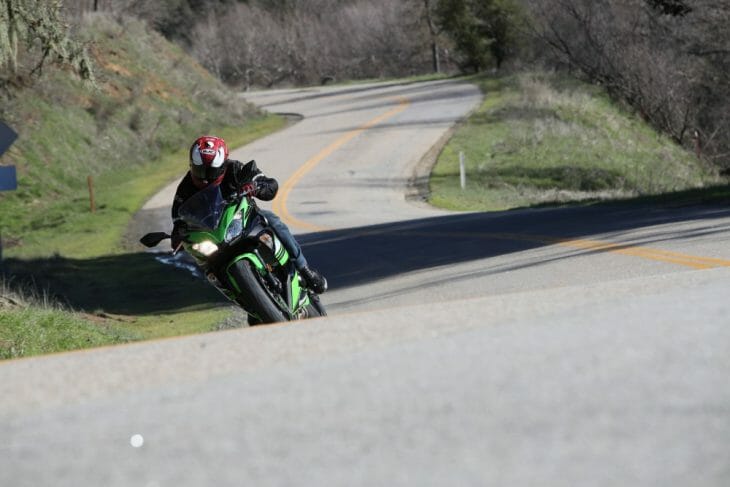 Paso Robles with a Ninja 650 is a pretty rad place to be…
Paso Robles with a Ninja 650 is a pretty rad place to be…
By Mark Miller
Photography by Brian J Nelson
“Be honest,” were the last words that Cycle News’ Road Test Editor Rennie Scaysbrook said to me before I left to Paso Robles to test and review Kawasaki’s completely re-vamped 2017 Ninja 650.
Okay, here’s my most honest try.
My wife and I will be buying two of these new Ninja 650s, ASAP. One each. True story.
Why?
At the absolute root of this story is the fact a few engineers behind one of our most beloved motorcycle manufacturers, Kawasaki, have just completed a very long, thorough, and complex crusade to design and build a brand new, from-the-ground-up, sporty, real-world streetbike and it is my opinion their hard work has paid off in spades.
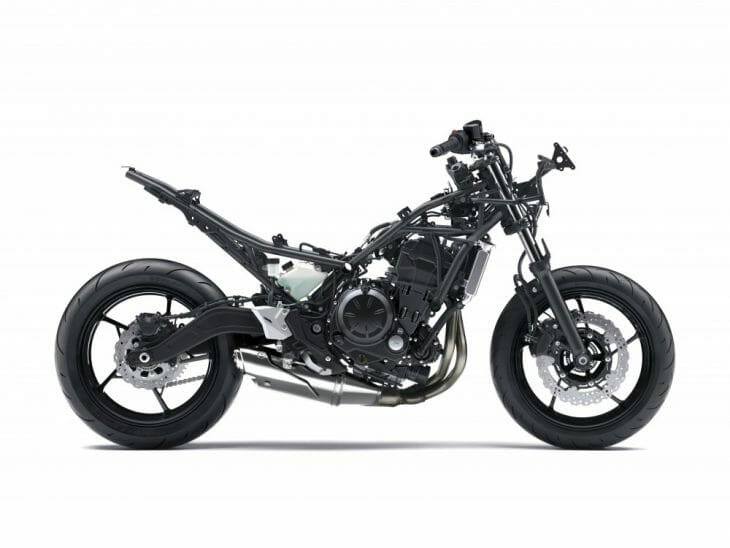 Every area of the new 650 has been optimized to save as much weight as possible.
Every area of the new 650 has been optimized to save as much weight as possible.
It’s a good time to be alive, really, if you’re a motorcycle enthusiast looking to buy a new ride. Especially in this case, if the model you’re choosing happens to be among the company’s most important to their customers.
Case in point, since 2006, some 60,000 modern liquid-cooled parallel-twin motorcycles have been sold in the U.S. alone—70 percent of them being Ninja 650s. Sixty-percent of 650s purchased from Kawasaki in the past 10 years have been from first-time ever streetbike owners. Many of the remaining buyers are previous owners of machines like the Ninja 300 who are looking for a “bridge” of sorts between their smaller displacements machines and the more advanced, more aggressive (and expensive) supersports like a ZX-6R or ZX-10R.
A bike for every rider
For me personally, as an experienced street rider and professional racer, I have in the past migrated almost exclusively to the fastest sportbikes made available to us mere mortals. However, having just spent a full day atop a Ninja 650 riding along and over the beautiful green hills of Central California after a serious rain season, I do believe I may have just found the most enjoyable all-around sportbike I’ve ever ridden.
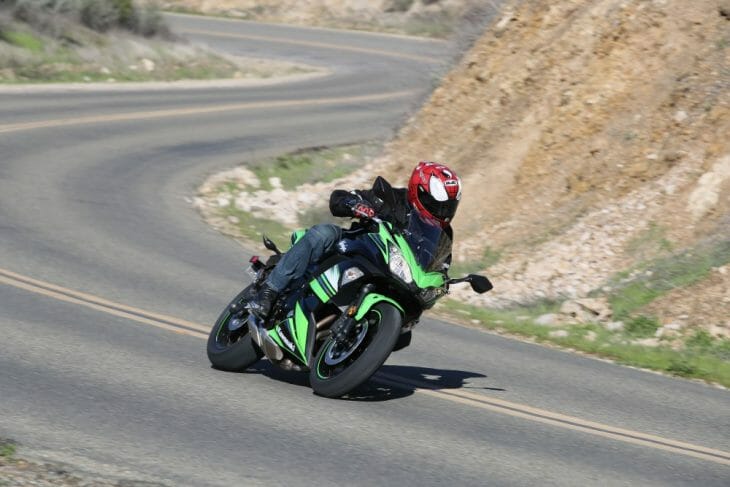 Aesthetically, the new 650 is now much closer in looks to the ZX-6R and ZX-10R.
Aesthetically, the new 650 is now much closer in looks to the ZX-6R and ZX-10R.
To be honest, 650cc parallel-twins have for the most part avoided my radar completely until about two years ago when I raced one and finished in eighth place on a Kawasaki 650 during an Isle of Man Lightweight TT. Flogging that little bike around the Mountain Course was so damn fun, I can still remember grinning inside of my helmet for the entire race.
There’s something very special about how the midrange of this particular configuration of motor, a parallel-twin, gets delivered. They don’t rev to the moon, they don’t accelerate in stupid powerful ways, they just kinda plod along with a certain, driven content. Our team’s Kawasaki 650 race engines were prepared by Carl Fogarty’s long-time mechanic Slick Bass, who lives and works on the Isle of Man, and boy did they croon. Still, on the whole, Kawasaki’s new 2017 model we just tested on the street is light years ahead of even our best 650cc racebike to date.
For starters, the new machine in street trim has lost some 42lb over just last year’s model. The weight removed for 2017 is about the equivalent of one of the heavy-as-f**k five gallon Sparkletts water bottles many of us have to carry upstairs from the garage to the kitchen. It’s a serious and tangible amount of weight.
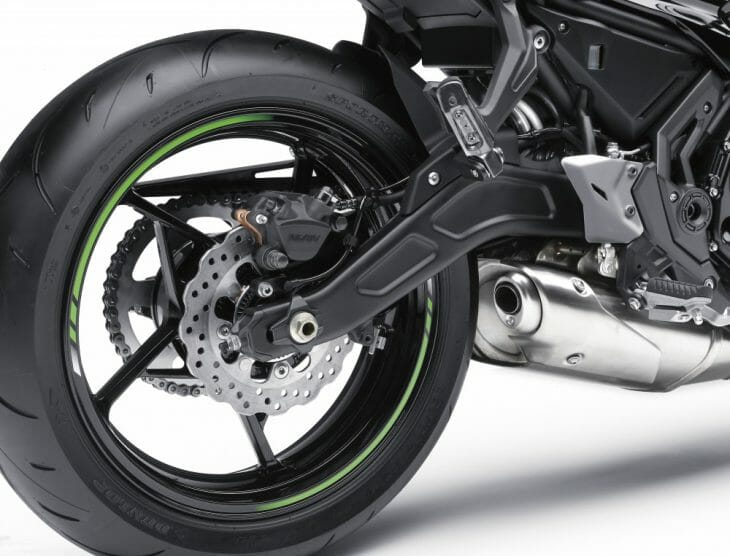 Kawasaki’s fitted a new swingarm that saves a further six pounds.
Kawasaki’s fitted a new swingarm that saves a further six pounds.
The chassis alone—redesigned by Kawasaki’s in-house analysis techniques to determine pipe diameters, lengths, and thicknesses (while avoiding bends)—has alone dropped an astounding 19lb over last year. The combined weight of the wheels is four pounds lighter; the swingarm is over six pounds lighter. The engine is 4.4lb lighter and the many remaining components (exhaust and bodywork, etc) when added up, save an additional eight pounds.
The bore and stroke remain the same (since it’s 2006 inception) at 83mm x 63mm, but additional 2017 enhancements include lighter Nissin brakes, 41mm KYB telescopic forks, and a high-tensile steel trellis frame which uses the engine as a stress-member. There’s a new gull-arm type swingarm, sportier bodywork, a centered horizontal progressive back-link suspension, shorter exhaust system with the cross-pipes removed for improved midrange, new engine cases with a semi-dry sump (with less drag from common “stirring loss”), and now a redesigned cassette-style gearbox allows for a gear position indicator and easy-neutral finder.
There are new camshafts with reduced operating angles and overlap which promote better midrange, a new sophisticated Bosch 9.1M ABS braking system, and Kawasaki’s Air Management System (KAMS), which directs hot engine air down to the ground and away from the rider.
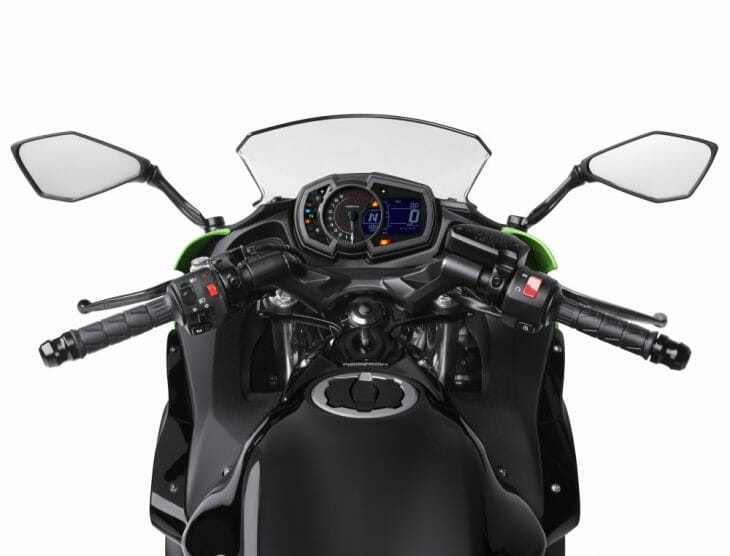 The dash has been reworked and now includes a gearshift indicator.
The dash has been reworked and now includes a gearshift indicator.
And the 180-degree crankshaft now runs with two balancer shafts to keep vibration to a minimum, plus there’s a new slipper clutch with a mechanical assist function that aids in a lighter pull on the lever.
Further, the hybrid clip-on style handlebars are now 25mm more forward and 42mm lower than in 2016, the foot pegs are also 15mm lower and 60mm more forward lover ast year’s and the seat height has been slightly lowered.
The bike’s windscreen has three adjustable heights and there’s a new dash display with a fuel gauge, fuel economy aid, and a user-adjustable shift light indicator.
Race style rather than race speed
This is not a racebike of course but these added touches of detail like a shift light can sometimes become usable in the real world for example if you’re rushing down an onramp to match the high speed of an intimidating freeway and want to keep your eyes on the merging traffic instead of your tach—its bright, illuminating shift light can keep you informed as to how close you’re getting to the higher RPMs as twins can sometimes run out of over-rev quite abruptly.
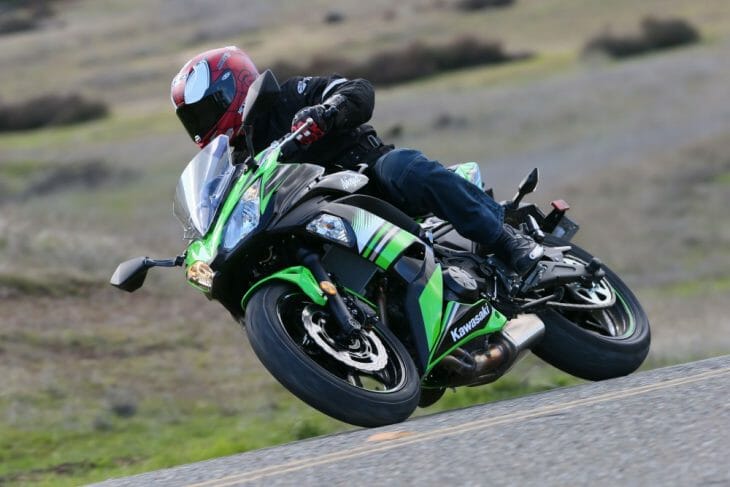 A slightly more aggressive riding position has helped the Kawasaki slay corners better than the outgoing model.
A slightly more aggressive riding position has helped the Kawasaki slay corners better than the outgoing model.
I think, however, Kawasaki’s greatest achievement on this bike comes from a combination of slimmer 36mm intake ports, improved fuel atomization, and a sub throttle valve system whereas the main valve is operated by the rider and the sub valve opens by a servomotor controlled by the ECU. So, if I whacked the main throttle open quickly, there was never a hesitation of any kind.
The whole bike has been re-tuned to create the best possible midrange—the result is a torque curve that’s smooth and responsive which led me to ask, “How could this motor possibly be more usable and amusing for the street?”
With peaky, aggressive 600 supersport bikes you’ve got to rev them hard to get anywhere fast. With big liter bikes, although there’s no greater heaven to having a rare opportunity to stretch their legs, for everyday street riding they’re just so damn fast. It’s more fun for me to hear and feel a motor rev through its designed range without the need for 145mph just to get into fourth gear with commitment. It’s a time and place kinda thing.
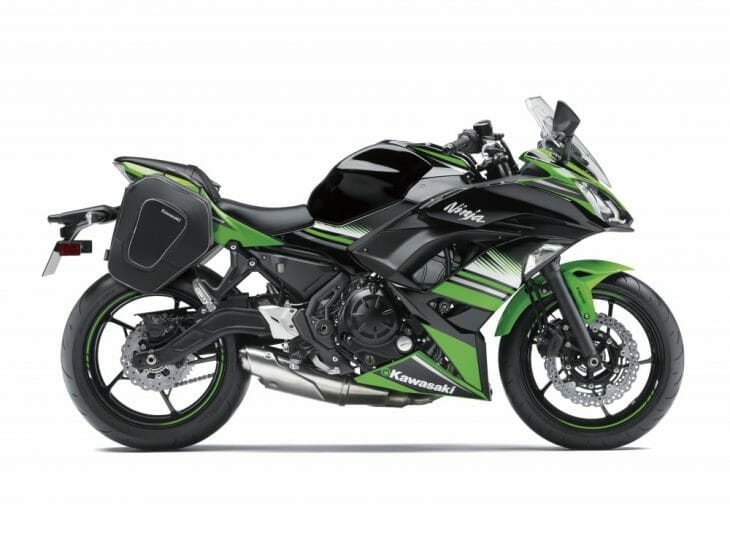 The optional saddlebags have been nicely integrated to the design.
The optional saddlebags have been nicely integrated to the design.
But for daily street carving, it’s the hooligan-like acceleration that proves most wicked and something you want to do every eight seconds for no good reason when riding this perfectly tweaked mid-sized twin.
The ergonomics of the 2017 Ninja 650 offer a great compromise between a traveler’s riding position and full tilt elbow-down Malibu twisty road mode. Terrific brakes for the money and I thought the Dunlops they come with worked excellent.
So, yeah, as an all-around daily sport bike for the street, that’s me happy. I want one.
Specifications
2017 Kawasaki Ninja 650 Sport ABS
Engine: 4-stroke, liquid-cooled, DOHC, 16 valve, inline-four
Displacement: 649cc
Bore x stroke: 83 x 60mm
Compression ratio: 10.8:1
Fuel system: EFI. 36mm throttle bodies
Exhaust: 2 into 2 into 1
Transmission: Six-speed gearbox.
Chassis: Aluminum composite twin spar
Front suspension: Telescopic fork. 4.7 in wheel travel
Rear suspension: Horizontal back-link, adjustable spring preload. 5.1 in wheel travel
Front brake: Dual 300mm petal-type rotors with four-piston calipers, ABS
Rear brake: Single 220mm petal-type rotor with single-piston caliper, ABS
Front tire: 120/70 ZR17
Rear tire: 160/60 ZR17
Rake: 24°
Trail: 3.9 in
Wheelbase: 55.5 in
Seat height: 30.9 in
Fuel capacity: 4.0 gal
Weight: 410 lb. (ABS, curb, claimed); 405lb (ABS, curb, claimed)
Color: Metallic Flat Spark Black/Metallic Spark Black, Pearl Flat Stardust White/Metallic Spark Black
MSRP: $6,999 ($7,399 for ABS model)
Click here for all the latest motorcycle test and reviews.
Click here for all the latest Kawasaki motorcycle test and reviews.